How Do You Know if Water Kefir Is Ready
Gut-friendly, probiotic, fizzy water kefir is naturally fermented and bursting with flavor! This ultimate guide to all things water kefir volition answer your burning questions — how to make it, shop it, season and bottle information technology for a second ferment… plus troubleshooting and my 5 best brewing tips!
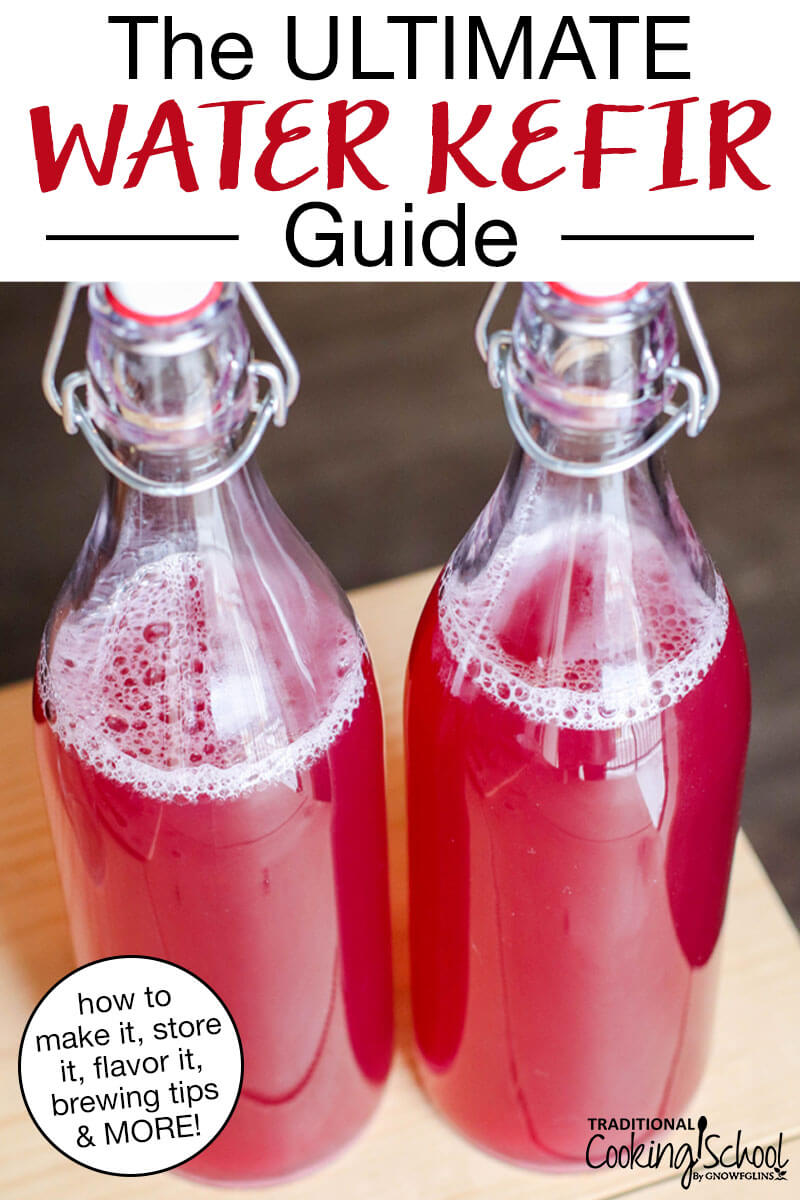
Trying to kick the soda habit?
Water kefir is an incredibly delicious fermented drink — the perfect natural soda!
Retrieve gut-friendly probiotics + refreshing fizz + endless season possibilities… AND information technology doesn't leave yous with a sickly sweet upset stomach. 🙂
We've been teaching TCS members how to make water kefir for over a decade now, and along the mode we've accumulated quite the list of FAQs, like…
- Which sweetener is all-time?
- How long to ferment?
- How to flavor it?
- Is it dissimilar than Kombucha?
- Is it different than dairy (or milk) kefir?
- And sooooo many more than!
So, in the same spirit equally our ultimate Kombucha guide, we've put together the ULTIMATE water kefir guide to respond all of your burning questions, aid y'all troubleshoot, and share brewing tips!
Permit'due south start at the starting time…
What is water kefir?
Similar to Kombucha (although not quite as pop), water kefir is a fermented drinkable. It is…
- dairy-complimentary
- rich with probiotics to aid a salubrious digestive system
- quick to brew
- a beneficial alternative to soda with endless flavor possibilities!
Substantially, we put water kefir grains (a symbiotic colony of lactobacilli and yeast) into a sugar water solution. The beneficial bacteria and yeast swallow the sugar (sucrose), and over 2 to three days of fermentation the saccharide water transforms into a mild, fizzy drink.
So, fifty-fifty though we offset with saccharide water… by the end, very footling sugar is left!
We tin can and so flavor it with fruit during a second fermentation to create a unique drink of whatsoever flavor you cull! We love grape, cherry (like this cherry-lemon flavor!), and ginger.
The second ferment is what makes h2o kefir really fizzy, so I do recommend making the extra effort to do this step. It's well worth it, I promise.
As long as you take care of your grains, they can be used indefinitely. This means natural soda is frugal likewise as healthy!
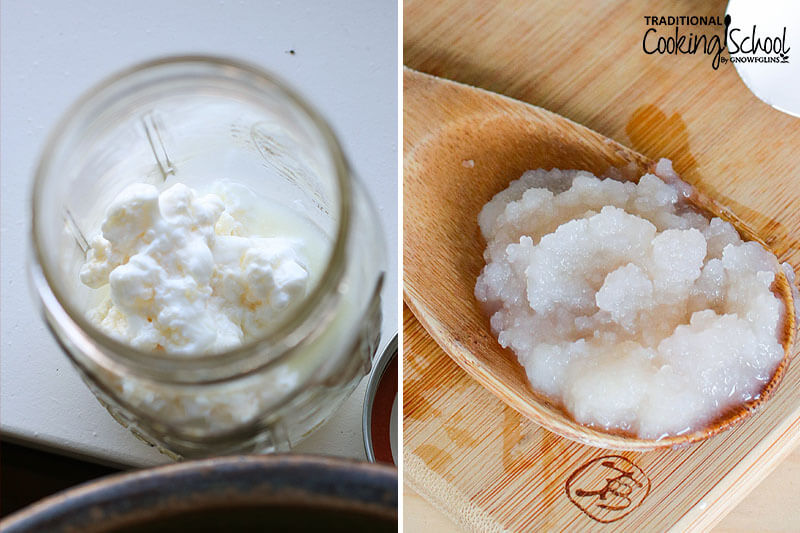
pictured, left to right: milk kefir grains, water kefir grains
Water Kefir Vs. Milk Kefir (Dairy Kefir)
H2o kefir is not the same as milk or dairy kefir.
In both types of kefir, the grains feed on sugar, leaving behind an acidic, fermented, slightly alcoholic (less than 1%), probiotic-rich beverage. Water kefir grains feed on any sugar is used in the sugar-water base of operations, while dairy kefir grains feed on the milk sugar lactose.
They do both take a mother civilisation chosen "grains", which are colonies of bacteria and yeast living together symbiotically. However, because the microbes vary in each culture, they look different.
Dairy kefir grains are rubbery, whitish clumps that await like cauliflower. Water kefir grains are somewhat translucent crystals or sharp little pebbles, and remain divide from each other.
Of class, the nigh obvious difference between them both is… the dairy! Water kefir is dairy-gratuitous, dairy kefir is not.
And guess what? You can really use dairy kefir grains to make water kefir through a conversion process.
The same grains won't work indefinitely, but since dairy kefir grains grow similar gangbusters in milk, if you keep them going in milk on the side, y'all'll have an endless supply — without investing in water kefir grains!
Learn how to make dairy kefir here!
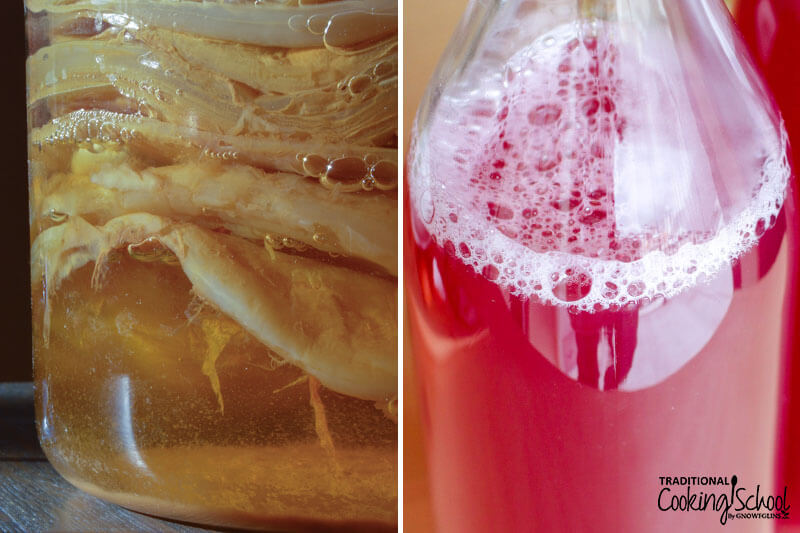
pictured, left to right: Kombucha scoby, bottled water kefir
Water Kefir Vs. Kombucha
Water kefir and Kombucha are likewise different. Although, both fermented beverages yield fizzy, probiotic, deliciously flavored drinks! 🙂
Even so, the mother cultures differ, and therefore the finished drinks do, too.
As mentioned above, the procedure of making water kefir relies on water kefir grains (a symbiotic colony of bacteria and yeast), whereas Kombucha requires a SCOBY (a different symbiotic colony of bacteria and yeasts).
Other differences include…
- Water kefir is quicker to brew than Kombucha.
- Kombucha typically has caffeine due to using green tea or black tea in the base liquid.
- Water kefir has a more plain base liquid (from the first fermentation), making it more adaptable to soda flavors that most people like and expect. Both can be an acquired taste, but water kefir less so!
Learn how to make Kombucha here!
5 Brewing Tips For The Best H2o Kefir
Water kefir tin exist a bit finicky. The grains don't grow as quickly every bit dairy kefir, and they tend to need a few special things to truly thrive.
Allow's talk about 5 tips for keeping your grains happy. 🙂
#1 — The Best Water
Water kefir grains dear minerals, then the best h2o to use is clean, pure, and mineral-rich spring water, well water, or filtered water.
If your water lacks minerals (such as water filtered past reverse osmosis), you tin employ mineral drops or a clean, rinsed eggshell to add together minerals back in. From a nutrient safe standpoint, you will have more than conviction when using a raw, but rinsed, pastured egg shell if it comes from a healthy poultry farm.
The h2o purification system from Radiant Life that nosotros personally use has a remineralization step built in, making it the perfect water for ferments! More info here.
Is chlorinated municipal water all you have? Boil information technology, assuasive the chlorine to vaporize. Then let the h2o cool to room temperature earlier making water kefir. Some other pick is to use a blender and blend the h2o; the aeration volition encourage the chlorine to vaporize.
#2 — The Best Sweeteners
Water kefir grains love minerals!
And so, the less refined (and mineral-rich) your sweetener, the better. Rapadura or Sucanat (unrefined cane sugar) are all-time.
However, this carbohydrate has a distinct season that some may not bask… and then you can also utilize evaporated cane juice which is more refined with a milder flavor, yet all the same contains minerals!
Considering using alternative sweeteners? Bank check out this commodity to answer the question "Can I Use Culling Sweeteners in Ferments?"
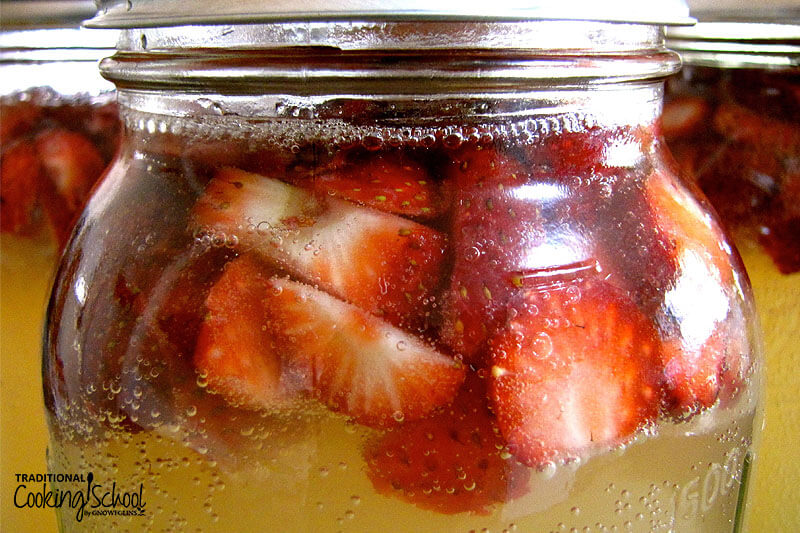
#3 — The All-time Flavor Ingredients
For the health of the mother culture, please choose organic ingredients equally much as possible. Chemical residues on conventional fruits and sugars can impairment the culture.
During the 2d fermentation (which is optional), you take an opportunity to "flavour" your water kefir with fresh or frozen fruit or fruit juices. Choose organic for these, too!
#4 — The Best Tools
Choose non-reactive utensils and containers. This means glass jars and wood, plastic, or stainless steel utensils and strainers.
If you're going to use stainless steel, go along its contact with the grains to a minimum — quick stirring or straining rather than prolonged contact. (Stainless steel is the least reactive of the possible metals you will find in kitchen utensils.)
Nearly people, whose grains don't multiply rapidly, will benefit from using a cotton fiber muslin pocketbook for holding and keeping grains together. Not only can y'all transfer the grains from batch to batch easily, but you won't have to spend time and effort separating them from the egg shells.
All the same, if your grains are thriving and multiplying rapidly they tin can fill the bag quickly, and end to thrive. For those whose grains are growing past leaps and premises (both through multiplying and through private grains growing big) it is actually best to let the grains bounce gratuitous in the batch.
They volition literally bounce up and down in the jar during fermentation if they're happy! It'southward fun for children to watch!
#5 — The Best Environment
Brew at least 5 feet away from other cultures, to prevent cantankerous-contamination. (Learn more than how to tell if your ferment has get contaminated in this commodity.)
H2o kefir needs an environment around room temperature to ferment well. Ideal room temperatures are betwixt 70 and 85 degrees Fahrenheit.
Fermentation times will be longer with the libation temperatures and faster with warmer temperatures. With temperatures much over 80 degrees Fahrenheit, exist vigilant to prevent spoiling.
When h2o kefir ferments too long, you can tell because the grains and the beverage seem "slimy" or syrupy and perchance more yeasty in olfactory property and gustation. This doesn't ever mean it has gone bad, but letting the kefir get to this indicate should be avoided because it's not pleasant to drink.
Rehydrating The Grains
Unless someone shares grains with you, you lot'll have to buy h2o kefir grains. (We recommend getting them from Cultures for Health.)
Rehydrate according to the bundle directions. Information technology takes three to 5 days in sweet water to rehydrate them and get them going again. The package from Cultures for Health gives enough grains to brand around iii/iv gallon of water kefir at a fourth dimension.
How To Store Water Kefir Grains
Water kefir grains may be stored, when non in use, in the fridge in a minor amount of sugar water.
Dissolve 1-1/2 teaspoons of sugar in 1/2 loving cup of water. Allow to cool, and then cascade into an airtight glass bowl.
Add the bag of kefir grains (well-nigh 1/four cup) and put the container in the refrigerator. This will continue for one or ii weeks.
If stored much longer, I recommend draining the liquid and replacing it with fresh, cool sugar water, or transferring the grains to the freezer for long-term storage.
How To Flavor Water Kefir
Flavoring water kefir is also known as second fermentation, or bottling.
Information technology's actually easy, and ways that your homemade natural soda will accept WAY more than fizz!
Yous tin can use almost anything to infuse water kefir with succulent flavors:
- fresh, frozen, or dried fruit
- fruit juices, like grape or ruddy
- splash of bootleg vanilla extract
- fresh rhizomes and herbs, like grated ginger
To bottle (aka second ferment), all you lot need are drinking glass swing-top bottles and fruits and/or spices of choice. Only identify 6 to 10 pieces of cut upwards, dried fruit (or about 1/iv cup fresh or frozen) into the bottoms of the glass bottles.
Then, make full with water kefir, shut, and prepare in a warm place for 1 to three days. If your dwelling is cold, a bulb warming mat volition help.
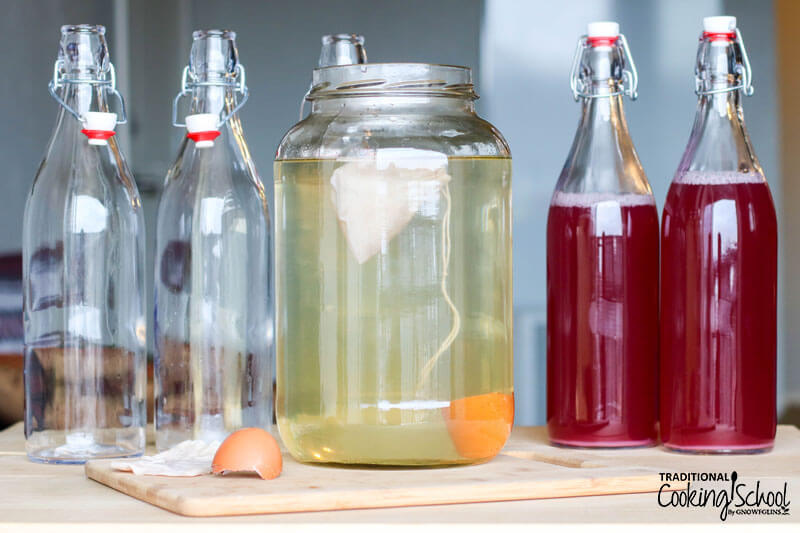
How To Store Finished Water Kefir
Though you can't see them, h2o kefir contains tiny bacteria and yeasts that will keep to feed on the remaining sugars, fifty-fifty after the brew is finished. As long as it has warmth, sugar, and oxygen, the fermentation procedure volition continue.
Remove one of these factors, and fermentation stops… Which is vital if your h2o kefir tastes just like you want information technology to and you're ready to store information technology!
Thus, it is necessary to store finished batches in airtight containers in the fridge, especially so they don't explode later edifice carbonation for days on end!
The all-time fashion to store it? Glass, swing-peak bottles in the fridge!
These are airtight, and you lot tin safely store finished water kefir in them in the refrigerator for months and months.
If you don't want to buy swing-top bottles, the side by side best thing is brand-new seals for Mason jars. Information technology doesn't matter if the band is new or not; but the seal needs to take plenty of wax on it to keep air out.
Water Kefir Troubleshooting
If you lot ever find yourself scratching your head, wondering, "Where did I go wrong?!" on your water kefir journey, yous're non alone! And, nosotros're here to help.
Allow'south run through the mutual water kefir issues and how to troubleshoot them.
Why Is It Even so Sugariness?
In that location are a few reasons this could be happening, like…
Information technology hasn't fermented long enough. If this is the case, requite information technology a few more days or move it to a warmer spot to speed upwards fermentation.
Your location wasn't warm enough. As with all ferments, water kefir loves a warm — not hot — spot. Its platonic temperature is between seventy and 85 degrees Fahrenheit.
Colder months tin be an especially difficult time for kefir grains because they're common cold if your house is cold. Try relocating them to higher up your refrigerator or oven, to an upstairs room, or to a high shelf.
This is also when you might detect a seedling warming mat handy!
The grains aren't getting enough minerals. Minerals are a MUST with water kefir! Revisit my best tips, above, to see if your water and sugar choices could be tweaked. Perhaps you demand to add together an egg shell or mineral drops to boost mineral content?
Your grains need more time to acclimate. Assuming that there are plenty of minerals (egg shell, h2o, sweetener), it is possible that your grains are withal getting used to your setup.
You can showtime fresh, perhaps with a smaller batch of sweet water, and keep acclimating them until they're working. If your setup lacks minerals, investigate increasing the corporeality of minerals — through mineral drops, adding a bit of molasses, using an egg beat, and a less refined sweetener.
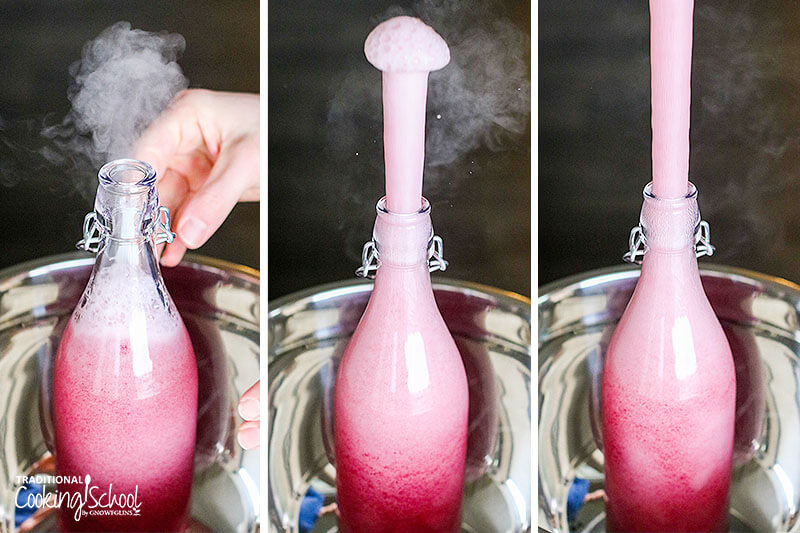
Why Isn't It Fizzy?
It's a huge let-down to hear all about the wonderful bubbliness of homemade natural sodas… merely to experience flat water kefir when you make it yourself. Hither are a few reasons why you lot might experience a lack of buzz:
It hasn't fermented at all or hasn't fermented long enough. No fermenting = no buzz. Again, requite it more than time and/or move information technology to a warmer spot to encourage those bacteria and yeasts to become to work.
It isn't warm plenty. H2o kefir ferments best at a temperature between 70 and 85 degrees Fahrenheit. Give the beneficial microorganisms a boost past relocating them to higher up your fridge or oven, to an upstairs room, or to a high shelf.
This is also when y'all might detect a bulb warming mat handy!
Your grains aren't getting enough minerals. They need to be eating and growing to create a nicely carbonated drinkable. Add an egg vanquish, mineral drops, or molasses to boost minerals.
Or, alter to a more mineral-rich sweetener like Rapadura. Brand certain y'all're not using contrary osmosis h2o, also.
The container for the second ferment isn't air-tight. If air can get out, it can't build up.
That's why we recommend doing a 2d ferment in glass, swing-top bottles or in Stonemason jars with tight lids. Just make sure non to exit them at room or warm temperature also long or you *might* have explosions.
Why Aren't My Grains Growing?
Here are the most common reasons kefir grains could fail to thrive.
Not enough minerals. Make certain y'all're using mineral-rich water and carbohydrate (encounter my all-time tips, above). As well, consider adding an egg vanquish, mineral drops, or molasses to farther increment minerals.
They're out-growing their muslin bag. Although a muslin bag can be helpful to keep your water kefir grains all in one place, if y'all're using one and your grains were thriving but suddenly they aren't anymore, this could be why.
Ditch the bag and let your grains float freely instead.
They're running out of food. Water kefir grains are more sensitive to being neglected — whether in the fridge where they need to be fed every one to two weeks or at room temperature where they should exist fed virtually every ii days.
Continue to a normal routine, as detailed in this mail, to brand sure your grains are healthy and fed!
Why Is It Slimy, Thick, or Syrupy?
Slimy water kefir is another common issue. Here are a few reasons this could happen.
It fermented besides long. Allowing your kefir to ferment for longer than necessary (24 to 48 hours, or upward to 5 days if the temperature is cool) tin can encourage an imbalance of yeast to abound, resulting in a slimy, thick, syrupy drinkable with a yeasty odor or taste.
Information technology may take a few batches to fix this, only persevere. Cease the outset ferment earlier, and either motion your water kefir to the fridge, or proceed to the bottling step.
You can besides rinse your grains in pure, uncontaminated water before beginning another batch. If the upshot doesn't resolve inside a few batches, I would toss the grains and first with fresh ones.
The temperature is as well warm. Fermentation happens much more quickly at warm temperatures, and for water kefir, y'all take to be vigilant to foreclose spoiling at temperatures over 80 degrees Fahrenheit.
The signs of over-fermenting due to temperature are the same as above: slimy or syrup-y beverage, and possibly a yeasty smell or taste. Movement your ferment to a cooler place if possible.
Over the course of a few batches, stop the first ferment sooner. Yous can also try rinsing your grains in pure, uncontaminated h2o to help reset the microorganism balance.
Over again, if the issue doesn't resolve within a few batches, toss the grains and start over.
Can I Do Anything Else With H2o Kefir?
Besides drinking it, you mean? 😉
Sure! If you really have lots of extra water kefir, hither are some ideas…
- Utilise it as the acidic medium for soaking grains and beans, similar you would with Kombucha or raw apple cider vinegar.
- Employ instead of whey as a dairy-free starter civilization for ferments such as cranberry relish.
- Brand a water kefir granita.
- Utilize information technology as the liquid base of operations for smoothies.
- Make water kefir tea.
- Boost your gluten-free sourdough starter (flavored or unflavored h2o kefir works for this!).
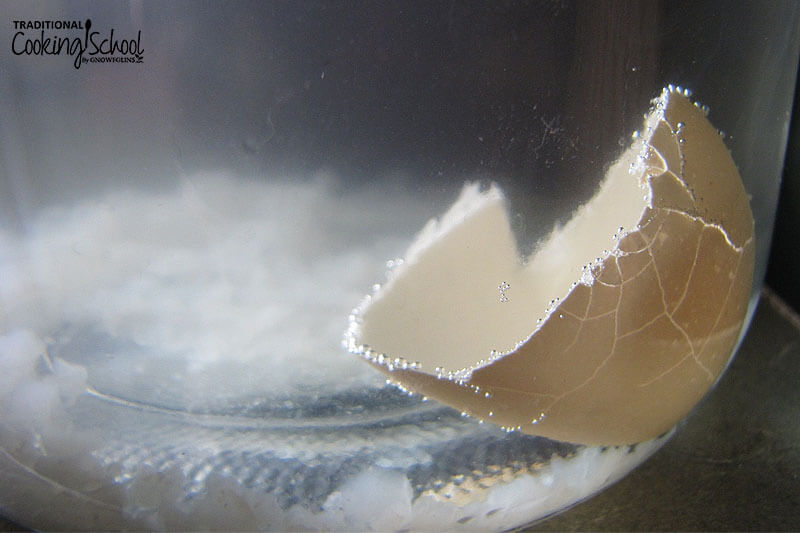
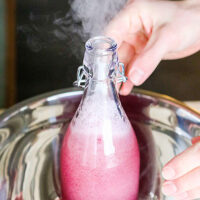
Homemade H2o Kefir
Gut-friendly, probiotic, fizzy water kefir is naturally fermented and bursting with flavor!
Prep Fourth dimension 10 minutes
Fermenting Time iv days
- i/4 cup h2o kefir grains fully hydrated
- 3/iv gallon pure water
- 3/4 cup sweetener
- 1/2 pastured or organic egg beat out rinsed
- 2 cups grape juice organic; or other flavoring options (encounter Notes)
For the first ferment...
-
Dissolve 3/iv cup of carbohydrate in nearly 1 cup of water, by bringing it all to a boil in a 3 to 4 quart pot.
-
Make full a gallon-sized drinking glass jar with about halfway with cold water.
-
Once sugar is dissolved, remove from rut, and pour sugar water solution into the gallon jar.
-
Add additional common cold water to fill the gallon jar to about 3/four full, or almost to the shoulder of the jar.
-
Add 1/iv loving cup of hydrated water kefir grains to the jar. These can be free-floating, or in a cotton wool muslin bag.
-
Add egg beat out (or mineral drops stirred into the water before adding the grains).
-
Cover with a paper towel or material napkin and secure with rubber band.
-
Allow h2o kefir culture, at room temperature, away from other ferments, for 24 to 48 hours, or even up to five days if temperatures are cool. The amount of sugar will decrease over time, as the grains consume information technology.
-
Stop this fermentation when you're happy with the amount of remaining sweetness. There may or may not be bubbles. Don't depend on bubbling for a sign that this is working — depend on reduction in amount of sugariness.
-
When you are happy with the outset fermentation, remove h2o kefir grains* (either pull out the muslin bag or utilize a strainer to separate them from the water kefir).
-
Shop grains in the refrigerator or freezer (run across Recipe Notes below), or utilize to first another batch. All you demand is 1/iv cup of h2o kefir grains to make ane gallon of h2o kefir, so feel costless to share any actress with friends!
-
Retrieve the egg vanquish(s) with a wooden spoon.
For the second ferment...
-
To the gallon jar, add organic grape juice.
-
Carefully (using a funnel) pour the flavored water kefir into Grolsch-style swing-top bottles. VERY IMPORTANT: Fill only to the shoulder, or slightly below! Leave room for the carbonation to build. Do not overfill.
-
Allow to sit down at room temperature for one to iii days.
-
Burp every 12 hours or and so, using caution to release the pent-up gases. Yous can do this in a large bowl to catch overflow so it's not wasted.
-
When you're happy with the flavor and carbonation level, store in the refrigerator or in cool storage. Bask!
Water Kefir Grain Storage
H2o kefir grains may exist stored, when non in apply, in the refrigerator in a modest corporeality of sugar water.
- Dissolve 1-one/2 teaspoons of sugar in ane/2 loving cup of water.
- Let to cool, so pour into an airtight glass bowl.
- Add the bag of kefir grains and put the container in the refrigerator. This volition proceed for one or two weeks.
If stored much longer, I recommend draining the liquid and replacing it with fresh, cool sugar h2o, or transferring the grains to the freezer for long-term storage.
Flavor Ideas
- 1/2 loving cup raisins + 1-1/2 tablespoons of vanilla
- 1/2 cup chopped, pitted dates + 1-one/2 tablespoons of vanilla
- 2 to four tablespoons grated fresh ginger + ane/4 loving cup fresh lemon juice + a splash of vanilla
- 1/2 cup stale fig pieces + 1-one/2 tablespoons of vanilla
- half-dozen stale peach slices + splash of vanilla
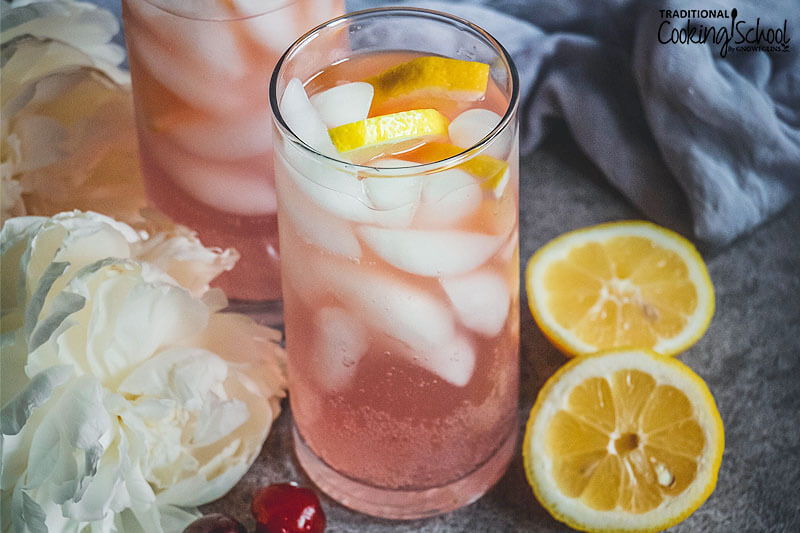
Looking for more yummy probiotic-rich drinks?
- Love-Sweetened Ginger Beer {probiotic, non-alcoholic, GAPS-friendly natural soda!}
- 50+ Probiotic & Fermented Drinks Beyond Kombucha & Kefir!
- Is Jun Right For You? All Your Questions Answered!
- How To Make Beet Kvass
- Gut-Salubrious Reddish Lemon H2o Kefir (refreshing natural soda!)
- The ULTIMATE Kombucha Guide {how to make it, store information technology, flavor it, SCOBY intendance, troubleshooting, and More!}
This post was originally published and written by Wardee Harmon on 12/17/09. It was updated and republished on 7/03/20.
Nosotros simply recommend products and services nosotros wholeheartedly endorse. This postal service may contain special links through which nosotros earn a small commission if you brand a purchase (though your price is the same).
stockstillquirded1953.blogspot.com
Source: https://traditionalcookingschool.com/food-preparation/how-to-make-water-kefir/

0 Response to "How Do You Know if Water Kefir Is Ready"
Post a Comment